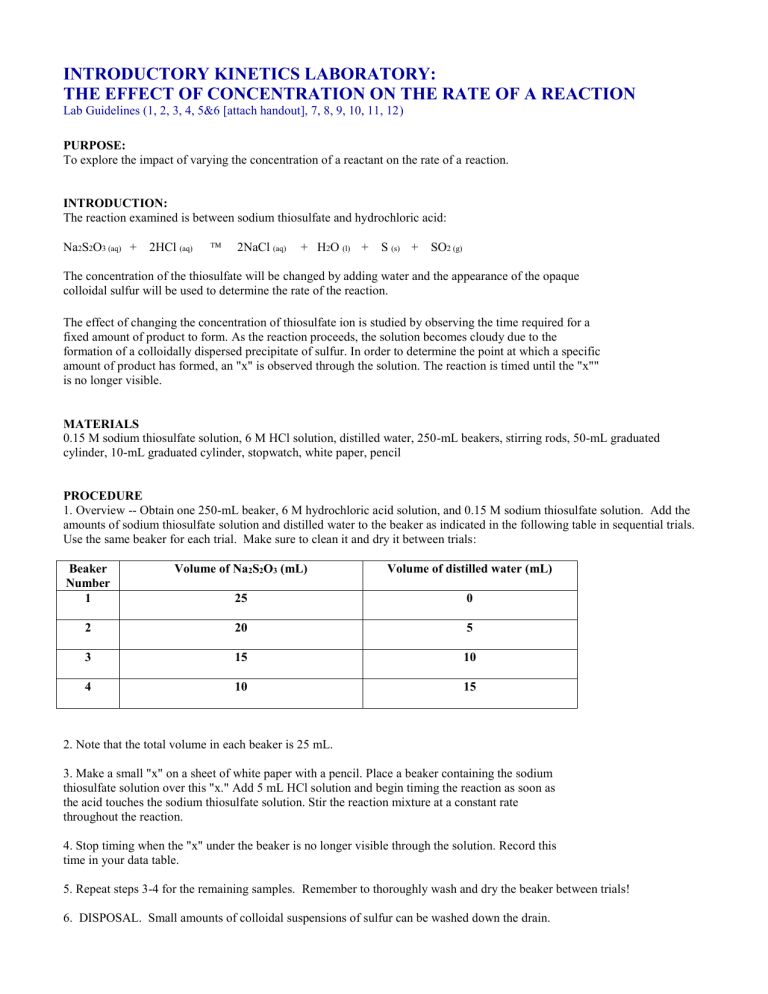the effect of concentration on the rate of a reaction

INTRODUCTORY KINETICS LABORATORY:
THE EFFECT OF CONCENTRATION ON THE RATE OF A REACTION
Lab Guidelines (1, 2, 3, 4, 5&6 [attach handout], 7, 8, 9, 10, 11, 12)
PURPOSE:
To explore the impact of varying the concentration of a reactant on the rate of a reaction.
INTRODUCTION:
The reaction examined is between sodium thiosulfate and hydrochloric acid:
Na
2
S
2
O
3 (aq)
+ 2HCl
(aq)
2NaCl
(aq)
+ H
2
O
(l)
+ S
(s)
+ SO
2 (g)
The concentration of the thiosulfate will be changed by adding water and the appearance of the opaque colloidal sulfur will be used to determine the rate of the reaction.
The effect of changing the concentration of thiosulfate ion is studied by observing the time required for a fixed amount of product to form. As the reaction proceeds, the solution becomes cloudy due to the formation of a colloidally dispersed precipitate of sulfur. In order to determine the point at which a specific amount of product has formed, an "x" is observed through the solution. The reaction is timed until the "x"" is no longer visible.
MATERIALS
0.15 M sodium thiosulfate solution, 6 M HCl solution, distilled water, 250-mL beakers, stirring rods, 50-mL graduated cylinder, 10-mL graduated cylinder, stopwatch, white paper, pencil
PROCEDURE
1. Overview -- Obtain one 250-mL beaker, 6 M hydrochloric acid solution, and 0.15 M sodium thiosulfate solution. Add the amounts of sodium thiosulfate solution and distilled water to the beaker as indicated in the following table in sequential trials.
Use the same beaker for each trial. Make sure to clean it and dry it between trials:
Beaker
Number
1
Volume of Na
25
2
S
2
O
3
(mL) Volume of distilled water (mL)
0
5 2
3
20
15
4 10
2. Note that the total volume in each beaker is 25 mL.
10
15
3. Make a small "x" on a sheet of white paper with a pencil. Place a beaker containing the sodium thiosulfate solution over this "x." Add 5 mL HCl solution and begin timing the reaction as soon as the acid touches the sodium thiosulfate solution. Stir the reaction mixture at a constant rate throughout the reaction.
4. Stop timing when the "x" under the beaker is no longer visible through the solution. Record this time in your data table.
5. Repeat steps 3-4 for the remaining samples. Remember to thoroughly wash and dry the beaker between trials!
6. DISPOSAL.
Small amounts of colloidal suspensions of sulfur can be washed down the drain.
DATA:
Make a table that shows the information in the table above and also includes a column for time (sec), and relative rate (sec
-1
).
Leave room for a data table containing Class Averages.
GRAPHS:
1. Make a graph of the class data by plotting the time (in sec) for each reaction on the y-axis against the volume (in mL) of sodium thiosulfate stock solution on the x-axis. (NOTE: Use Class Average Data)
2. Plot the reciprocal of the time (1/T, i.e. one divided by the time) versus concentration of thiosulfate. The reciprocal of time is a relative measure of the rate of the reaction. (NOTE: Again, Use Class Average Data)
CALCULATIONS:
1. a) Calculate the concentration of the thiosulfate ion for each trial. Show your work. (Don’t forget to include the 5 mL of added acid to your dilution calculation).
b) Calculate the concentration of the hydrochloric acid for each trial.
2. Create a new table. For each trial, list the concentration of the thiosulfate ion, the concentration of the hydrochloric acid, and the relative rate (sec -1 ).
3. Now create graph #2 mentioned above.
4. Use the table created in calculation #2 and the “change factor” equation mentioned in class to determine the order of this reaction with respect to thiosulfate ion. Remember you will need to compare pairs of reactions to one another in order to accomplish this. Do all possible reaction pair comparisons (How many are there?), and then determine the average value for the order of the reaction with respect to thiosulfate ion.
QUESTIONS:
1. In step 1, why was it necessary to keep the total volume constant at 25 mL? As the volume of sodium thiosulfate solution used was decreased, how did the concentration of Na
2
S
2
O
3 change?
2. What relationship exists between the volume of sodium thiosulfate solution used and the time it takes for the reaction? What relationship exists between concentration and time?
3. Simply put, how does the relative rate of the reaction vary with concentration of sodium thiosulfate solution?
If the concentration of the sodium thiosulfate solution doubled, what would happen to the relative rate of the reaction?
ERROR ANALYSIS:
Calculate you percent error for the order of the reaction with respect to thiosulfate ion. Also, comment on possible sources of error and their impact on your results.
CONCLUSION:
Write a conclusion which demonstrates that you understand what you did. How did you accomplish the purposes? Discuss the math as well.
Remember, here is a great guide for writing your conclusion:
1) Restate the purpose
2) Summarize the procedure and data collection
3) Discuss any important principles / equations used
4) Explain the graphs and/or math
5) Report your results
Also, please include any other interesting information you would like to add.











